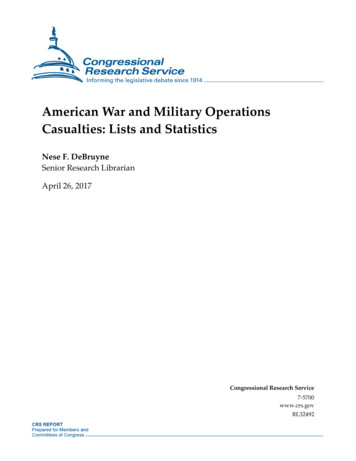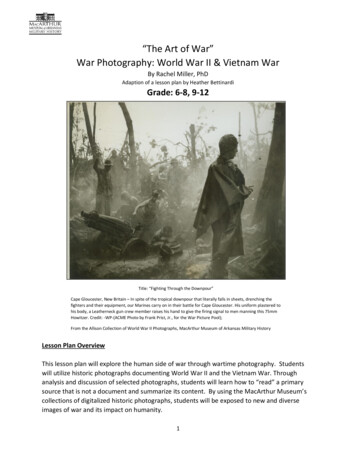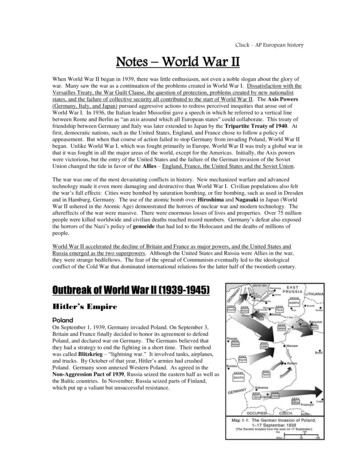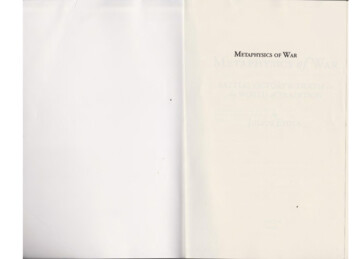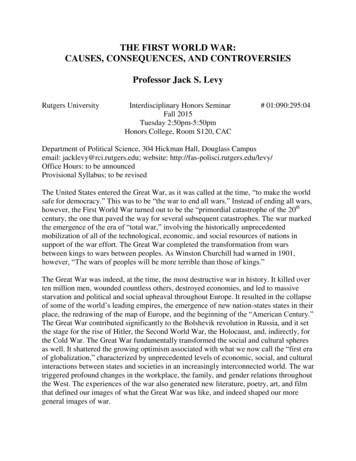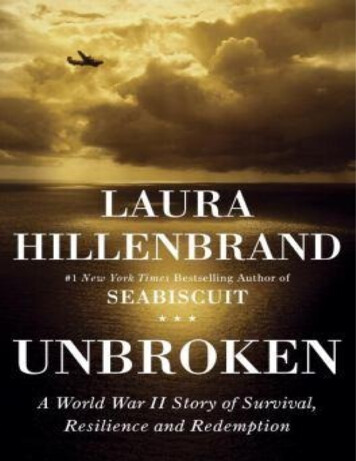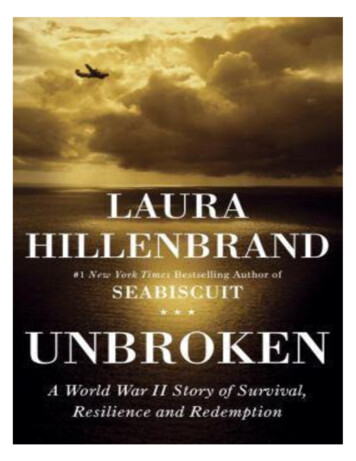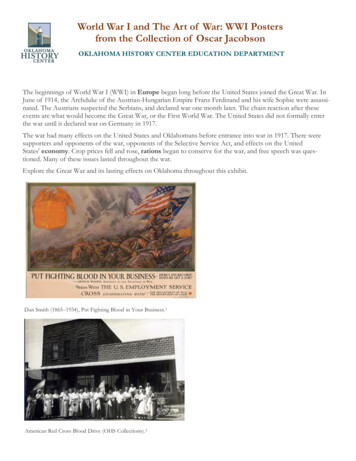
Transcription
World War I and The Art of War: WWI Postersfrom the Collection of Oscar JacobsonOKLAHOMA HISTORY CENTER EDUCATION DEPARTMENTThe beginnings of World War I (WWI) in Europe began long before the United States joined the Great War. InJune of 1914, the Archduke of the Austrian-Hungarian Empire Franz Ferdinand and his wife Sophie were assassinated. The Austrians suspected the Serbians, and declared war one month later. The chain reaction after theseevents are what would become the Great War, or the First World War. The United States did not formally enterthe war until it declared war on Germany in 1917.The war had many effects on the United States and Oklahomans before entrance into war in 1917. There weresupporters and opponents of the war, opponents of the Selective Service Act, and effects on the UnitedStates' economy. Crop prices fell and rose, rations began to conserve for the war, and free speech was questioned. Many of these issues lasted throughout the war.Explore the Great War and its lasting effects on Oklahoma throughout this exhibit.Dan Smith (1865–1934), Put Fighting Blood in Your Business. 1American Red Cross Blood Drive (OHS Collections).1World War 1 and the Art of War 2017 1
World War I and The Art of WarTimeline1914June 1914 – Franz Ferdinand, archduke of Austria-Hungary, and his wifeSophie are assassinatedJuly 1914 – Austria-Hungary declares war on SerbiaAugust 1914 – Germany declares war on Russia, France, Belgium, and invades FranceBritain declares war on Germany and Austria-HungaryUS declares its neutral stanceFrance declares war on Austria-HungaryJapan declares war on GermanyAustria-Hungary declares war on Belgium and invades Poland (Russian)Franz Ferdinand and wife Sophie (imagecourtesy of Smithsonian Magazine) 3(OHS Collections)4October 1914 – Commission for Relief in Belgium(Image courtesy The National WWI Museum and Memorial.) 5World War I and the Art of War 2017 2
1915January 1915 – Bread rationing introduced in GermanyMay 1915 – German U-boat torpedoes the civilian ship Lusitania, including 128 US citizensLusitania leaving New York Harbor (image courtesy of the Library of Congress). 61916June 1916 – National Defense Act signed into law expanding the size and scope of the US militaryNovember 1916 – Woodrow Wilson is reelected1917February 1917 – US severs relations with GermanyApril 1917 – US declares war on Germany and officially enters WWIMay 1917 – Selective Service ActJune 1917 – Espionage ActFirst US Troops arrive in FranceFirst Liberty LoanJuly 1917 – First lottery of draftDecember 1917 – The Eighteenth Amendment is passed and prohibition beginsWorld War I and the Art of War 2017 3
1918January 1918 – 14 PointsPoster promoting Daylight Saving Bill (image courtesy Library of Congress). 7March 1918 – Daylight saving time begins in the USNovember 1918 – Armistice (eleventh day, eleventh month, eleventh hour) WWI ends(Image courtesy of the Library of Congress.) 8World War I and the Art of War 2017 4
1919January 1919 – Peace conference in ParisFebruary 1919 – League of Nations createdJune 1919 – Germany and Allies sign the Treaty of VersaillesJuly 1919 – Treaty of Versailles is submitted to the SenateAugust 1919 – The Nineteenth Amendment passed by Congress giving women the right to voteNovember 1919 – Treaty of Versailles not ratified by Senate(Image courtesy of the Library of Congress.) 9World War I and the Art of War 2017 5
The Economy and the War EffortThe US economy was in a recession when the Great War began. Crop prices went down when Germany blockaded several Allied ports, which in turn hurt several Oklahoma farmers. In late 1916, crop pricessoared when European markets opened up which not only helped the farmers, but also eased anxieties aboutthe US entering the war.The US being able to finance the military during wartime was becoming a possibility. Before the US entered thewar, not only did crop prices rise, but industry expanded. The US began manufacturing goods for the militaryand the Allies, expanding the need for workers anddecreasing the unemployment rate. People were encouragedto support the war effort by rationing food, working to produce the goods the soldiers needed in a factory, orby monetary support. Once the US entered the war, the was encouraged public to share their support of militaryby buying war bonds.(Image courtesy Library of Congress.)11(Image courtesy Library of Congress.)10(Image courtesy Library of Congress.)11World War I and the Art of War 2017 6
Oklahomans in WWIThe Great War affected everyone in the United States in many different ways. Oklahoma is home to war supporters, protesters, war heroes, and draftees. In 1917, Congress passed the Selective Service Act. This requiredall men to register for military service if they were between twenty-one and thirty years old.This Act and the war itself faced resistance in many places and fueled a small uprising in Sasakwa, Oklahoma in1917. The issues with the war ignited an already hostile group of land owners and tenant farmers, who joinedthe Socialist Party in the hopes of changing government and public policy about things such as land use andland taxes. They met near Sasakwa, planning to march to Washington DC, eating beef and roasted green cornon their way. Their uprising ended with a meeting of posses, resulting in three dead and more than 400 arrestedafter they burned several bridges and cut telegraph lines.First Oklahoma/Thirty-Sixth Infantry Division and Code TalkersThe First Oklahoma Infantry unit was a National Guard unit. It was the first group from Oklahoma to becalled upon in the Great War. They met with other units in 1917 at Camp Bowie, Texas, to become a part ofthe Thirty-Sixth Infantry Division.The Thirty-Sixth arrived in France in the summer of 1918 and returned to Texas in spring of 1919. Duringtheir time in France, the Thirty-Sixth Infantry fought victouriously in the battle at Ferme Forest.In France, the communications code was intercepted and broken by the Germans. Needing a way to get theirmessages through company lines, runners were used, but several runners were captured and their messages never delivered. After overhearing Choctaws speaking to each other in their native language, an officer began training the "code talkers." The code talkers sent messages via writing and by field telephone, resulting in severalvictories. Many tribes became code talkers including men from the Choctaw, Cherokee, Comanche, Cheyenne,and Osage tribes.Tobias Frazier, Code Talker (OHS).12World War I and the Art of War 2017 7
Posters and PropagandaPropaganda is defined by the Merriam-Webster Dictionary as "ideas,facts, or allegations spread deliberately to further one's cause or todamage an opposing cause."Propaganda takes several forms: it can be a celebrity endorsing aproduct, an advertisement on television or in the newspaper, asign in the neighbor's yard supporting a politician, a political cartoon, just about anything! During World War I, the majority ofpropaganda from all sides was in the form of posters. Posterswere popular and the artists' designs were eye-catching and easilyreprinted. Posters could also reach several people in multiple locations.These posters encouraged people to be informed and get involved in the war effort. They asked men to join armed forcesand women to join relief organizations. They inspired people tobuy bonds and help others around the world. The posters helpedgenerate a real fear of the enemy, and helped raise support for thewar in several countries and on all sides. The following are someexamples of posters issued from the Allied and Central powers governments.Australian poster (image courtesy of the Libraryof Congress).18British poster (image courtesy ofthe Library of Congress).17Shall We be more Tender with Our Dollars, Dan Sayre Groesbeck(image courtesy of the The National WWI Museum andMemorial).19World War I and the Art of War 2017 8
British poster (image courtesy of the Libraryof Congress).20Enlist/On Which Side are You? 1917, Laura Brey(image courtesy of Smithsonian Magazine).21(Image courtesy of the University of Leeds.)22World War I and the Art of War 2017 9
Central Powers Propaganda PostersTranslation: "You, too, should join the Reichswehr. Therefore, sign up at the next enlistment post, ReichswehrGruppen-Kommando no. 4 (Bavarian), Möhl, Major General" (image courtesy of the Library of Congress). 23Translation: "Help Us Win! Subscribe to the War Loan" (imagecourtesy of The National WWI Museum and Memorial).26Translation: "This is how it would look inGerman lands if the French reached theRhine" (image courtesy of the Imperial War Museums).25World War I and the Art of War 2017 10
Translation: "Imperial and Popular Fund for the Army and theNavy. Frankfurt Christmas Charity Day 1917. Contributions to14 Theaterplatz, Office 5" (image courtesy of the Imperial WarMuseums).27Translation: "If the enemy's hate and army win, the workplaceswill stand empty. Before closed doors, you'll have to tie up yourbundles in hunger" (image courtesy of the Imperial War Museums).28Poster showing Allied soliders running from German troops. Translation:"We Teach You to Run!" (image courtesy of Boston University).24World War I and the Art of War 2017 11
Artists and Posters from The Art of War ExhibitOscar Brousse Jacobson (1882–1966)Oscar Brousse Jacobson was born on May 16, 1882, in Westervik, Kalmar Lan, Sweden. He emigrated toLindsborg, Kansas, in 1890 and studied at Bethany College, receiving a bachelor's degree in 1908. He continuedhis studies at the Louvre in Paris, in Sweden, and in Denmark. In 1916 he received a master of fine arts degreeat Yale University and in 1941 a doctorate of fine arts from Bethany College in Lindsborg. He worked as director of the School of Art at the University of Oklahoma (OU) from 1915 until 1954. He and his wife, Jeanned'Ucel, had three children: Yvonne, Oscar Jr., and Yolanda.Jacobson's name is synonymous with early-twentieth-century art in Oklahoma. Educated in Europe and America, he tirelessly promoted the arts in the young state. One genre, traditional Plains Indian art, is now inexorablybound to him and to the University of Oklahoma. Because Jacobson held Indian people in high regard andtreated them with respect, he became their champion and mentor. In the late 1920s he and Professor Edith Mahier, also of the OU art school, worked with a small group of five Kiowa men and briefly with one Kiowa woman. These artists and their style became world famous and have always been associated with Oscar B. Jacobson.In addition, he founded the Association of Oklahoma Artists and formally advised the Works Progress Administration's Federal Art Project for Oklahoma in the 1930s.A prolific painter of Southwestern landscapes, Jacobson exhibited his work throughout the United Statesand Europe. He won numerous awards, including a Gold Medal at the 1931 Mid-Western Exhibition at theKansas City Art Institute Invitational. He was made an honorary chief of the Kiowa tribe and was inducted intothe Oklahoma Hall of Fame in 1949. He lectured at the Metropolitan Museum of Art in New York, at the Chicago Art Institute, and at more than fifty universities and colleges. His works are held by the Woolaroc Museumat Bartlesville, Oklahoma, the Jacobson Gallery in Norman, the Oklahoma City Museum of Art, and the FredJones Jr. Museum of Art in Norman. On September 15, 1966, he died in Norman.Gordon Grant (1875–1962)Gordon Grant was born in San Francisco, California, in 1875.He was educated at the Fife Academy in Scotland and at theHeatherly & Lamberth Art School in London. After completing his formal art training in 1896, Grant began working as anillustrator for the Examiner and the Chronicle in San Francisco.In 1899, Grant started working for Harper's Weekly as anartist/correspondent covering the Boer War in South Africa.From 1901 to 1909 he worked as an illustrator for Puck Magazine in New York City. At age thirty-two Grant enlisted in the7th New York National Guard for service during the PunitiveExpedition against Mexico in 1916. Upon the entry of theUnited States into World War I in 1917, the Army stationedGrant in Washington DC with the rank of captain. After theArmistice in 1918, Grant continued to work as an illustratorand painted oil and watercolor paintings of marine subjects.His painting of the ship Old Ironsides hangs in the WhiteHouse.During World War I, manufacturing could not keep up withthe US Navy and Merchant Marine demand for binoculars.The shortage of these instruments prompted a request to theAmerican public from the Department of the Navy for binoculars, spyglasses, telescopes, sextants, and chronometers. Thegovernment asked the public to send these instruments to theSecretary of the Navy. Upon passing inspection of the scien- Will You Supply Eyes for the Navy?, Gordon Grant (courtesy oftific instruments, the Navy would send a letter of thanks to the the Library of Congress).29donor, a check for 1 rental, and the promise that the loanedWorld War I and the Art of War 2017 12item would return at the end of the war.
James A. Daugherty (1889–1974)Daugherty studied art at the Corcoran School of Art. After completing his formal education Daugherty was commissioned toproduce posters for various government agencies. Daugherty wasone of the first American artists to print abstract and near abstract compositions based upon the power of color relationships.During the Great Depression, Daugherty painted murals for theWPA from 1934 to 1939. In 1940, Daugherty received the JohnNewbery Medal for illustrating a children's book on DanielBoone.The United States Congress created the Emergency Fleet Corporation in 1917 to establish, construct, and manage a fleet of shipsto aid in defense shipping and overseas commerce. The Emergency Fleet Corporation produced both steel and wooden shipsfrom hundreds of shipyards on both the east and west coasts.This fleet transported American fighting forces to France andsupplied both the Allied armies but also the people of France,England, and Belgium.The Ships are Coming, James A. Daugherty (imagecourtesy of the Library of Congress).30William Henry "Haskell" Coffin (1878–1941)Haskell Coffin was born in Charleston, South Carolina, in 1878.He studied art at the Corcoran School of Art. After completinghis formal education he painted society portraits of the leadingfamilies of Charleston. In 1902 he traveled to France to train informally with artists there. Coffin specialized in images of women and produced cover art for The Saturday Evening Post, The American Magazine, Redbook, McCall's, Leslie's Illustrated, and the PictorialReview. Coffin committed suicide in 1941.The United States incurred a large amount of debt in fightingWorld War I. To offset that cost, the Treasury Department issuedLiberty Bonds and War Savings Stamps. Average citizens purchased the lower cost stamps for as little as ten cents with the intention to accumulate the stamps to equal a 5 War Savings Certificate. Purchasers could redeem the Certificate for Liberty Bonds. Americans could purchase a stamp for 4.12, whichwould pay 5 upon maturity. The stamps and certificates reachedfull maturity in 1926.Joan of Arc Saved France, Haskell Coffin (image courtesyof the Library of Congress).31World War I and the Art of War 2017 13
Sidney H. Reisenberg (1885–1971)Sidney Reisenberg was born in Chicago, Illinois, in 1885. He studied art at the Art Institute of Chicago. In 1905 after completing hisformal education, Reisenberg worked as a curator at the HudsonRiver Museum of Art. He later taught art at the Westchester ArtsAssociation. His first illustration appeared in People's Home in 1912.Reisenberg also worked for The Saturday Evening Post, Harper's Weekly, and Boy's Life. After the Armistice, Reisenberg continued to workas an illustrator for pulp magazines."Over the Top" was phrase used during the war to describe thefundamental activity of trenchwarfare. Soldiers would have toclimb out of their defensive trenches and "over the top" of theparapets to mount an offensive attack. As the casualties of the wargrew in number, the term more and more came to describe the excessive, foolhardy actions that created the senseless waste of lifeassociated with World War I and trench warfare. Shortly after theend of the war, the term came to symbolize its current meaning anduse of excessive action.Over the Top For You, Sidney Reisenberg (image courtesy of the Libraryof Congress).32John A. Coughlin (1885–1943)John A. Coughlin was born in Chicago, Illinois, in 1885. He studiedart at Notre Dame beginning in 1900. After finishing at NotreDame, Coughlin studied art under the guidance of Jobson EmilienParadis. Further studies also included time at the Art Institute ofChicago. By 1912, Coughlin had his own studio in New York City.Within a year he was painting covers for various magazines. For thenext twenty years he built a career by painted pulp magazine covers.In fact, his cover for a 1931 issue of Detective Story Magazineis thefirst appearance of the The Shadow.The United States Marine Corps served in France assigned to thearmy's 2nd Infantry Division. In the early summer of 1918, the German army began an offensive designed to win the war before American troops deployed thoroughly across the front lines. This offensive punched a hole through French trenches and came within fiftyfive miles of Paris. The 4th Marine Brigade and the 7th InfantryRegiment stopped the petering German drive at Belleau Wood, aforest near Belleau, France. The battle to push back the Germantroops in Belleau Wood began with the first American offensive ofWWI on June 6, 1918. The battle continued for three more weeks,resulting in 10,000 American casualties, and witnessed the creationof the German nickname for the Marines of Teufel Hunden or "DevilDogs."Go Over the Top/US Marines, JohnCoughlin (image courtesy of the Library of Congress).33World War I and the Art of War 2017 14
Henry Raleigh (1880–1945)Henry Raleigh was born in Portland, Oregon, in 1880. He dropped out of art school when he was twelve years oldand began working on the docks. There his natural talent impressed his boss who subsequently paid for Raleigh toattend the Hopkin's Academy in San Francisco. After graduating, Raleigh began working as an illustrator forthe San Francisco Bulletin. He later worked for Vanity Fair, Harper's Bazaar, Collier's, and The Saturday Evening Post.Raleigh is perhaps the most prolific illustrator of this time period. Government agencies created 5 million copiesof his WWI poster titled Hunger. For most of his career as an illustrator, Raleigh earned enough income that heonly worked four months of a year and often gave away thousands of dollars. As tastes in illustrations changed,Raleigh found it harder and harder to earn a living. In 1945, he committed suicide by jumping from a high risebuilding in New York City.The name 'hun' is a reference to the fourth-century tribes comprising an empire under Attilla. These nomadic people marked the end of the Roman Empire and often described as warlike. Drawing a connection between the hunsand the soldiers of the German Empire served to demonize the enemy and increase recruitment in the UnitedStates.Hun or Home?, Henry Raleigh (image courtesy of theLibrary of Congress).34Blood or Bread, Henry Raleigh (image courtesy of theLibrary of Congress).35Food rationing in the United States began in August of 1917 shortly after the declaration of war. The governmentcreated the United States Food Administration to manage the supply, conservation, distribution, and transportation of food. Not only did the United States supply troops in France, but also the civilian populations of AlliedEuropean nations. Posters created by the agency implored Americans to reduce their food consumption, rationavailable supplies, and to change their diets to more fruits and vegetables, which were too difficult to transportoverseas. This rationing and supply program continued past the Armistice and garnered its director, Herbert Hoover, the nickname of "The Great Humanitarian."World War I and the Art of War 2017 15
Adrian Gil Spear (1885–1965)Adrian Gil Spear was born on August 11, 1885, in Camden,New Jersey. Information on his formal art training is unknown. By 1915, Spear wrote the script of the motion picture Poet and Peasant for the Lubin Manufacturing Company.He went on to write or contribute to scripts for fifteen moremotion pictures as an employee for the Famous Players Lasky, an early movie production company. Additionally he created the artwork for several, if not all, of these filmsWorkers Lend Your Strength, Adrian Gil Spear (imagecourtesy of the Library of Congress).36James Montgomery Flagg (1877–1960)James Montgomery Flagg was born in Pelham Manor, NewYork, in 1877. By the age of fourteen he was a contributingartist for Life and Lodgemagazines. He studied art at the ArtStudents League of New York and fine art in London andParis for two additional years. Flagg created his most famouswork for the July 1916 issue of Leslie's Magazine to encourageenlistment in the US Army. He was inspired by a slightly older British recruiting poster featuring Lord Kitschener in thesame fashion as Uncle Sam. Over 4 million copies of thisposter were produced during World War I. Flagg may haveused his own face as the model for Uncle Sam. Before theArmistice, Flagg produced forty-six posters for the war effort.During the War of 1812 Sam Wilson, Revolutionary Warveteran and meatpacker in Troy, New York, supplied barrelsof salt beef and salt pork to army contractor Elbert Anderson for local United States troops. As well as supplying meat,Sam Wilson also served as a meat inspector for the army.Wilson marked barrels passing his inspection with "E.A.U.S.," the E.A. representing Elbert Anderson and the U.S.representing United States.Troops from the area familiar with Sam Wilson assumed thatthe barrels stamped "U.S." stood for Uncle Sam. It was fromthis assumption that the character Uncle Sam aroseDo It Now!, James Montgomery Flagg (image courtesyof the Dallas Museum of Art).37World War I and the Art of War 2017 16
Maginal Wright Enright Barney (1877–1966)Born Margaret Ellen Wright in Weymouth, Massachusetts, in 1877, she went by the nickname, Maginal, created by her mother and combining her first two names.She is the younger sister to noted architect Frank LloydWright. Barney attended the Chicago Arts Institute andbecame a commercial artist for Barnes, Crosby, andCompany in Chicago. Barney illustrated sixty-threechildren's books during her lifetime, an occupationshared with her husband. The art style of husband andwife are very similar. Among her more notable illustration work was for books by L. Frank Baum, the authorof The Wizard of Oz. Barney also worked as an illustrator for McClure's and Ladies Home Journal.War Gardens Over The Top, Maginal Wright EnrightBarney (image courtesy of the Library of Congress.)38Ellsworth Young (1866–1952)Ellsworth Young was born in 1866 in Albia, Iowa. Youngstudied at the Art Institute of Chicago. After completing hisstudies, Young went on to work for the Denver Times and TheChicago Tribune as an editorial illustrator. Young painted several posters during WWI. Remember Belgium, shown here, is hismost famous.The phrase "Remember Belgium" references the initial German attacks on France through neutral Belgium. The majorpowers of Europe guaranteed Belgium's independence andneutrality in an 1830 treaty between The Netherlands andBelgium. In 1914, German plans to attack the French Armyincluded an offensive drive through Belgium and into France,in order to trap the French Army along the nation's easternborder. During this offensive, the fear of Belgian saboteursand guerilla fighters motivated the German Army to commitnumerous atrocities against the civilian population. This offensive and counter-insurgency resulted in the entry of theBritish Empire into the war against Germany and Austria.Posters and other propaganda capitalized on the "Rape ofBelgium" as the cause for World War I, rather thanRemember Belgium, Ellsworth Young (image courtesyof the Library of Congress).39World War I and the Art of War 2017 17
Dan Smith (1865–1934)Dan Smith was born in Ivigtut, Greenland, in 1865. Smith migrated to the United States as a child with his parents. After studying art in the US, Smith traveled to Copenhagen, Denmark, at age fourteen to study at the PublicArts Institute. Upon returning to the United States, he began studies at the Philadelphia Academy of Fine Arts. In1890, Smith became an illustrator for Frank Leslie's Illustrated Weekly. One of his first assignments depicted themassacre at Wounded Knee, South Dakota. Toward the end of that decade, Smith worked for William RandolphHearst as an illustrator of the Spanish-American War. For the next twenty years he created cover art for the TheWorld and continued his work as a book illustrator.Outgoing President Taft created the United States Employment Service and the Department of Labor in 1913.This was to give organized labor a voice in a cabinet level department of the federal government. ThroughoutWorld War I, the Department of Labor worked to ensure that wages, hours, and conditions promoted warproductivity. The Department standardized the eight-hour workday and overtime pay for employees. After theArmistice, the Department of Labor focused on placing veterans back into the workforce by asking businesses toregister their personnel needs with them as a centralized employment service.Put Fighting Blood in Your Business, Dan Smith (image courtesy of the Library of Congress).1Created in 1917 by the American Library Association, the Library War Service wasone of seven organizations focused on making military posts more like home. Between 1917 and 1920, the Library War Service raised 5 million and created thirtysix working libraries at military posts. During the war, these libraries providedbooks in braille to wounded servicemen. While the focus was to create a home environment for soldiers to enjoy, before the end of the war the libraries increasinglyprovided technical manuals and textbooks for vocational training.Knowldge Wins, Dan Smith (imagecourtesy of the State Archives ofNorth Carolina).40World War I and the Art of War 2017 18
Unknown ArtistWorld War I for the United States lasted one year, seven months, and five days. During that time, the armedforces had 320,518 casualties. Those killed in and out of combat, wounded, and missing, comprise this total casualty figure. Of that number 116,516 men were killed, (53,402 from direct combat), 204,002 men were woundedin action, and 3,350 men are listed as missing in action. The Spanish Flu killed 35,000 men as it spread both inthe trenches of France and military installations in the United States.Men from Oklahoma filled the 36th, 42nd, and 90th Infantry Divisions. Those soldiers participated in four major operations or offensives in France. The 42nd Division participated in the ChampagneMarne Operation from July 15 to July 18, 1918, and experienced7,317 casualties in those four days. At that rate, combat actionkilled or wounded seventy-six men every hour. That division transitioned directly into the Aisne-Marne Operation, which took placefrom July 18 to August 6, 1918. That operation took an additional38,490 casualties in nineteen days, or eighty-four men every hour.The United States I Corps, which contained all three divisions, participated in the St. Mihiel Operation from September 12 to September 16, 1918. There were 8,600 casualties in four days. Ninety mendied or received a wound every hour. In the last offensive of thewar, the Meuse-Argonne Offensive, September 26 to November11, 1918, received 110,508 casualties in forty-five days; a casualtyrate of 2,456 each day or 102 every hour.They Invested Everything, unknown (Imagecourtesy of Digital History).41Sgt. Henry E. ClarkSgt. Henry E. Clark is the artist of this poster. Other than his rank,details of his life are unknown. The black cat featured on this posterand others of the period is associated with the Tank Corps of theUnited States Army. The stylized black cat is a cultural reference to theHindu-German-Irish Nationalists who sabotaged the munitions depoton Black Tom Island in New York Harbor in 1916. The depot onBlack Tom Island contained 1,000 tons of small arms and artillery ammunition, with another 100,000 pounds of TNT on a barge moored atthe dock.When the depot exploded, the concussion caused damage to the nearby Statue of Liberty and broke stained-glass in Manhattan. People asfar away as Philadelphia and Maryland heard it. This was just one ofseven acts of sabotage or manipulation by the German Empire beforethe entry of the United States into WWI. Among these were the sabotage of the Welland Canal on the St. Lawrence River, gun smugglingon the SS Annie Larson, arson of the Robling Wire and Cable Plant,bombing of the Vanceboro Bridge, the Great Phenol Plot, the bombing of the Mare Island Naval Shipyard, and an anthrax attack in Washington DC. The final act was the infamous Zimmerman Note whereinthe German government promised to return the southwestern UnitedStates to Mexico if the Mexican government would enter the war as anAxis ally. The Tank Corps took on the moniker "Black Toms" as thepersonification of revenge.Join the Tanks, Sgt. Henry E. Clark(image courtesy of Digital History).42World War I and the Art of War 2017 19
GlossaryUnderlined words denote Building Academic Vocabulary from the Oklahoma Department of Education.abdicate: To abandon or step down from power.alliance: A formal agreement between two or more nations to support each other.Allied Powers: Great Britain, France, Russia, the United States, Italy, and Japan; fought again
World War 1 and the Art of War 2017 1 The beginnings of World War I (WWI) in Europe began long before the United States joined the Great War. In June of 1914, the Archduke of the Austrian-Hungarian Empire Franz Ferdinand and his wife Sophie were assassi-nated. The Austrians suspected the Serbians, and declared war one month later.

